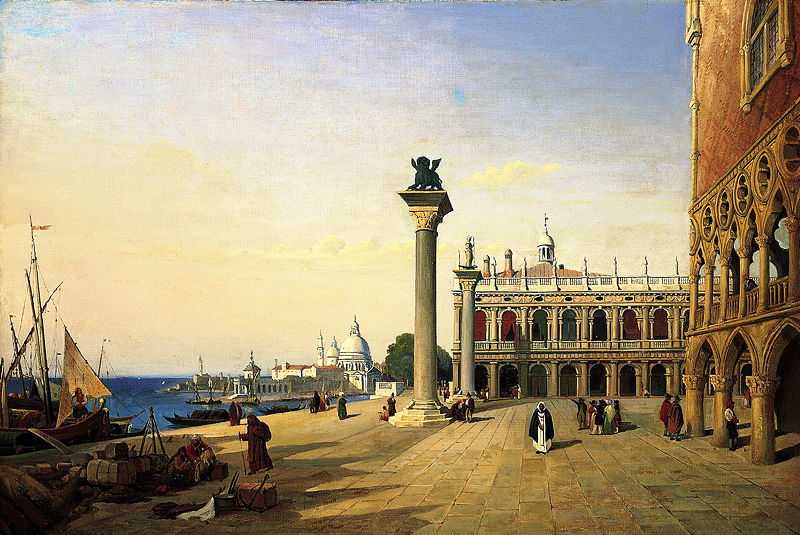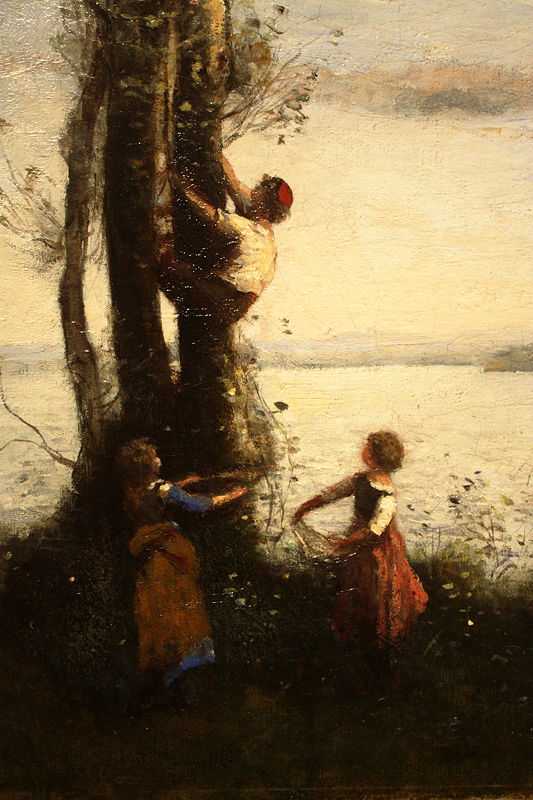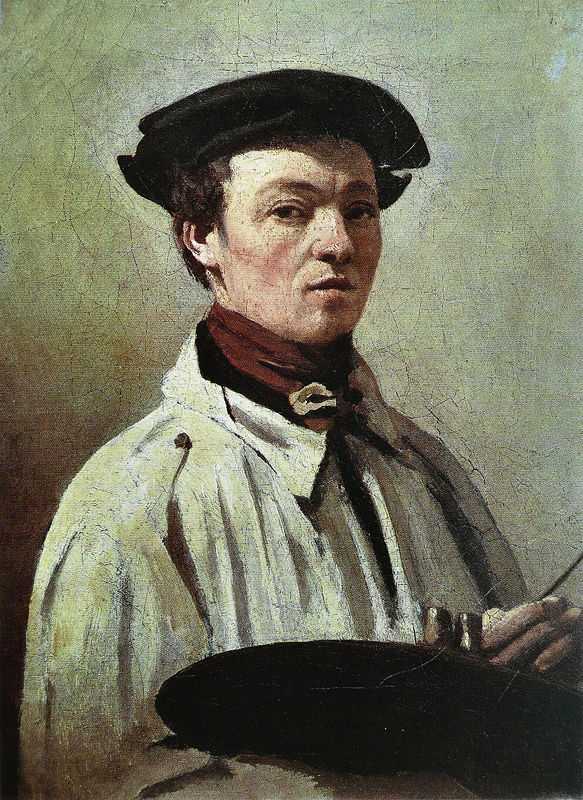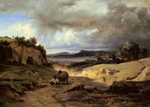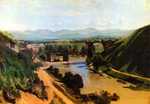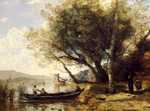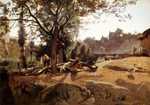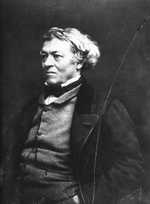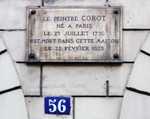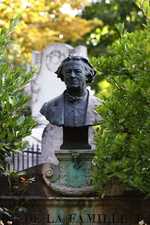1. Corot’s early years
Camille Corot was born into a prosperous Parisian household in 1796.
Corot’s family
His family were firmly middle-class. In particular, his mother, Marie Françoise Oberson Corot, helped to create a comfortable life for her children. She was a milliner from Switzerland and her wider family were wine merchants based in Versailles.
In her shop on the elegant corner of Rue du Lac and Quai Voltaire, Mme Corot made fashionable hats for middle and upper class Parisians. They quickly became a favourite among the Parisian bourgeois and were even purchased by the Empress Josephine.
The Corot family lived above the shop and from the window of their apartment, Camille could see the Louvre. His father, Louis Jacques Corot, was a draper - a cloth merchant - who helped manage the shop and oversee the finances. Like his wife, he was dedicated to the family business and together they succeeded in building a thriving business with an excellent reputation. As a result, Camille and his siblings benefitted from financial stability throughout their childhood and adult years.
Corot studies art
In 1817, Corot had already begun attending the art school Académie Suisse in Paris.
Around this time, his father also purchased a home outside Paris in Ville-d’Avray. Corot had inherited his father’s good health and strong physique and he enjoyed spending many hours outside in nature, rambling through the picturesque countryside. During the weeks spent at their summer home, Corot developed a strong fondness for the landscape around him.
This period was the start of his experiments with painting ‘en plein air’ and he continued to return to scenes from the Ville-d’Avray throughout his career.
According to sources, Corot had a close relationship with his parents and especially his mother. His father tried to persuade him to follow his trade and become a draper. Corot remained in an apprenticeship for eight years, where he learnt about colour, texture and design. However, after two successive attempts to complete his apprenticeship, both of which eventually failed, Louis was forced reconsider his son’s education.
At the age of 25, his father gave him financial support to pursue his love of painting.
Thanks to his family’s comfortable lifestyle, Corot never suffered as many of his fellow artists did. He was free to pursue his love of landscape painting without needing to sell large numbers of his works or receive generous commissions. Similarly, he had the funds to buy the supplies and studio space he required. It was this freedom which arguably allowed Corot to transform the genre as he did: he was able to focus solely on style and aesthetics rather than on making ends meet.
That is not to say, however, that Corot was not sensitive to public taste throughout his career. In the early 19th century, landscapes featuring figures were preferred, particularly with characters from myth, legend or the Bible. Hence, Corot endeavoured to please his audience with paintings such as ‘Hagar in the Wilderness’ from 1835 and ‘Homer and the Shepherds’ from 1845.
2. Corot’s landscape paintings
Where Corot truly excelled was in his depiction of landscapes.
Corot’s tutors
One of Corot’s earliest painting tutors was Achille Etna Michallon, a famous landscapist already famous for his oil sketches despite his youth. Unfortunately, Michallon died at the age of just 26 after contracting a sudden illness.
As a result, Corot was forced to begin studying under Jean-Victor Bertin. Bertin had also been a pupil of Pierre-Henri de Valenciennes with Michallon and was a Neoclassical landscapist, albeit not quite a prestigious. Valenciennes had strongly encouraged his students to paint landscape studies outdoors in order to experience nature in its rawest form and enhance their landscape paintings.
This teaching in turn, was passed onto Corot who dutifully followed Valenciennes example.
Corot’s Grand Tour
From 1825 to 1828, Corot travelled to Italy, visiting Rome, Campagna, Naples and Venice. A trip to Italy was somewhat of a rite of passage for young landscape artists at the time and he made the journey with Johan Karl Baehr, a fellow student from the same studio. Two of the paintings Corot made during this time were accepted to the Paris Salon of 1827, ’The Bridge at Narni’ and ‘Roman Campagna’.
The Bridge at Narni
‘The Bridge at Narni’, painted between 1826 and 1827, was made in the classical academic style, demonstrating Corot’s early dedication to Neoclassical painting. The ruins in the image provide a hint of mythology and the figures are in keeping with the nods to heroic figures that were fashionable in landscape painting at this time.
Whilst this final painting is polished and composed, the early oil sketch, now in a collection at the Louvre in Paris, indicates Corot’s interest in painting outdoors. The sketch has an energy which is missing from the large-scale painting, indicating his enthusiasm for sketching even early in his career.
In the first collection of paintings and sketches Corot made during his travels, he tended to use a limited range of colours. He endeavoured to work with the natural light he saw, building up landscapes of complementing colours and using darker and lighter tones to give his compositions a sense of depth. In fact, it was this mastery of tonality that would stand out throughout his career, perhaps as his defining skill.
Corot’s working year
The 1825 trip was Corot’s first visit to Italy but he returned numerous times, as well as travelling through Europe often during his lifetime. As a landscape painter, Corot chose to follow the rhythm of the seasons, working most prolifically during the spring and summer.
In the autumn and winter months, he would consolidate the many sketches he had made during the warmer months, transforming his studies into large scale canvasses in his studio in time for submission to the Salon. This regular routine was kept to throughout his career.
Corot and the Barbizons
In this way, Corot aligned himself with more naturally minded art movements, including the Barbizon School. He was close with many of the painters in the group, including Jean-François Millet and Théodore Rousseau. They shared the same interest in muted palettes that reflected the natural landscape and subtle tonal changes to denote depth.
He also painted the forest of Fontainebleau, a favourite spot of the Barbizon school, and one of these pieces won a second-class medal at the 1833 Paris Salon.
Despite the rapid changes happening around him as a result of the Industrial Revolution, Corot always depicted an idealised image of the French rural landscape. Unlike other artists who began incorporating steam engines and vast railways into their works, Corot remained firmly in the pastoral past. None of his paintings even hinted at the extreme social and industrial transformation taking place in his country.
Fame and commercial success
By the 1850s, Corot’s style had become even more softened and sensitive and it was during this period that his fame reached its peak.
He began to favour muted colour palettes of greys and simple blue-greens, moving towards an ever more melancholic visual vocabulary. In turn, he achieved much critical and commercial success and was able to fully support himself, moving out of the family home when his mother died in 1851.
As well as his landscape paintings, it should be noted that Corot also invented his own genre which he called ‘Souvenirs’. These works generally depicted figures in a generic landscape such as a lake or clearing in the woods. In doing so, Corot pulled threads of inspiration from his own imagination, whilst continuing to use his characteristic sensitivity and tonality to make the works convincing. Many of these paintings have a sense of mystery and solace to them and they were very popular, exhibited numerous times.
3. Corot and the Impressionists
As Corot’s fame grew, he was awarded with an increasing number of honours in French society.
Friend of the impressionists
One of these was the privilege of sitting on the Salon jury, where he was able to judge artworks submitted to the Salon, alongside with his colleagues. Corot used his influence to champion the emerging impressionist movement and the artists who were attempting to redefine French art. He defended their work among the thundering critics in the Salon.
As well as being a figure of support for the Impressionists, Corot was also a key source of inspiration for the movement. Corot’s dedication to painting ‘en plein air’ was undoubtedly his greatest influence on the Impressionists. Following the tutelage of his early painting masters, Corot dedicated his life to painting outdoors in order to render his landscapes in the most sensitive way possible.
His focus on natural light was one of the most significant points of reference for the Impressionists’ obsession with light. This pioneering approach to painting was a key step in the development of the Impressionist Movement and the starting point for the innovations of artists like Claude Monet,Camille Pissarro and Alfred Sisley.
Subject matter
As well as the importance of light, Corot was also notable in his choice of subjects. Though he often portrayed classical-inspired figures, some of his paintings also feature peasants doing manual labour, another precursor to the Impressionist’s focus on ordinary life.
In ‘Peasants under the Trees at Dawn’, painted between 1840 to 1845 in the town of Lornes, a handful of people are shown working on cutting down a tree. The soft light, mistiness and blurred faces gives the scene the sense of capturing a fleeting moment. The viewer can almost see the shadows under the tree moving as the sun travels across the sky.
This piece was made from a sketch, painting during one of Corot’s numerous visits to Burgundy. His father’s family were from the region and it was an area that Corot travelled to frequently. This painting calls to mind similar scenes painted later by Pissarro.
Corot, Pissarro and Morisot
Indeed, arguably Corot’s most notable relationship with the Impressionists was his tutelage of Camille Pissarro and Berthe Morisot. He was keen to teach younger painters and enjoyed his time passing on his knowledge. The old man became known fondly as ‘Papa Corot’ thanks to his careful and generous approach to his pupils.
Like many Impressionists, Morisot began painting outdoors, drawing much of her artistic vocabulary from Corot. As well as his landscape paintings, Corot painted female figures later in his career, though these were less popular and less well-known. Morisot’s female figures were modern Parisian women, living in the changing world of Paris being remade and redrawn under Haussmann during the 1850s and 1860s.
Nonetheless, they echo Corot’s artistic touch; his misty, silvery palette feeds into many of her works, as well as in her acute sensitivity to natural light.
As a direct consequence of having been born a woman at a time when women’s independence was severely restricted, Morisot was mostly confined to painting in garden settings.
She did not have the opportunity to travel as Corot had done, depicting monumental landscapes from Rome and beyond. In spite of this, Morisot used her limited freedom to create unique works, drawing on the shimmering effect of Corot’s landscapes but within a more familiar setting, especially in the gardens of her home.
Corot’s influence on Pissarro was slightly different. Pissarro was first introduced to Corot’s paintings at the Universal Exposition in Paris and Corot has often been cited as one of the most significant influences in the development of the artist’s career. Pissarro drew on Corot’s delicate brushstrokes, creating his own soft, loose style in parallel with his teacher’s work.
The delicate light in many of Pissarro’s paintings, whilst characteristic of the Impressionist movement, can be seen as derived from many of Corot’s sketches. His influence through Pissarro was also key for the Impressionist movement as a whole as Pissarro was a guiding figure in the development and continuation of Impressionism.
Corot and Degas
In conjunction, Corot inspired many of the Impressionists with his figure paintings, despite his reputation as a landscape painter. Edgar Degas praised Corot in 1883, after his death as, “still the strongest. He anticipated everything.” When some of his figure works were shown posthumously in 1909, they were highly praised by Cézanne and Picasso, demonstrating his enduring relevance for the Impressionists, the Post-Impressionists and onwards.
4. Corot’s legacy
On February 22 1875 at the age of 78, Corot died.
This was the year of the First Impressionist Exhibition. Though he was not alive to witness the success of the Impressionists, the legacy he left behind in their work was grand. He had successfully established landscape painting as a valued genre in French art.
At the same time, Corot paved the way for the appreciation of immediacy in painting through the veneration of his sketch-like works. This was hugely influential on the Impressionist movement, whose artists took this fleeting form of painting even further.
Towards the end of his life, after he had achieved financial independence and widespread recognition for his works, Corot’s focus began to shift somewhat. He began painting a number of studies and portraits of women.
These works were subdued and tranquil, echoing the stylistic tastes evident in his landscapes. Many of them are also melancholic, as seen in the introspective work ‘Italian Woman’ painted around 1870. However, they also show the artist’s experiments into looser and more expressive brushwork.
Corot chose never to display the majority of these paintings, suggesting that they were intended to be private studies rather than public masterpieces. This shift may have been in part due to his failing health, which restricted him to his studio and limited his ability to travel.
Was Corot lonely?
One cannot help but wonder if Corot was also suffering from loneliness in his later years, after the death of both of his parents. Corot never married and it is likely that he never had any serious romantic relationships. He was fully committed to his painting, as he emphatically put to his friend
“All I really want to do in life […] is to paint landscapes. This firm resolve will stop me forming any serious attachments. That is to say, I shall not get married.”
Despite his fame, Corot chose to live quietly and conservatively. He remained passionately devoted to his painting until the end of his life and his artistic legacy as one of the greatest landscapists in French history is now firmly established.

